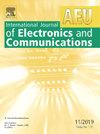用于5G n257/n258/n260/n261 NR网络的DNG超材料加载双宽带MIMO天线
IF 3
3区 计算机科学
Q2 ENGINEERING, ELECTRICAL & ELECTRONIC
Aeu-International Journal of Electronics and Communications
Pub Date : 2025-03-25
DOI:10.1016/j.aeue.2025.155775
引用次数: 0
摘要
采用DNG超材料设计的紧凑、高效、双宽带MIMO天线专为毫米波5G应用而设计。该超材料在双共振带内具有双负介电常数和磁导率。无超材料结构的MIMO天线具有两个相邻的对称辐射单元,在相应频段内的最大相应隔离度分别为- 29.05和- 26.09 dB。为了进一步缓解相互耦合,在衬底顶部表面的两个元件之间最佳地放置了一种超材料,将隔离度提高到- 39.81和- 42.81 dB。该天线在第一频段具有10.43 GHz (20.22 ~ 30.65 GHz)的宽带,在第二频段具有7.23 GHz (35.27 ~ 42.5 GHz)的宽带。这种紧凑的天线(26毫米× 14.5毫米)在各自的频段内提供5.5和5.2 dBi的峰值增益。此外,第一波段和第二波段的包络相关系数分别低于0.045和0.04,表明多样性特征较强。因此,规定的MTM-MIMO天线被证明是毫米波应用的可行选择,确保其与各种5G新无线电(NR)频段n257、n258、n260和n261的兼容性。这种多功能性有助于其在多个国家的部署,包括日本、瑞典、欧盟、美国、韩国、加拿大和澳大利亚。本文章由计算机程序翻译,如有差异,请以英文原文为准。
DNG metamaterial loaded dual wideband MIMO antenna with mitigated mutual coupling for 5G n257/n258/n260/n261 NR networks
A compact, efficient, dual wideband MIMO antenna with DNG metamaterial is designed for millimeter-wave 5G applications. The metamaterial has DNG (double negative) permittivity and permeability within dual resonance bands. The MIMO antenna without metamaterial configuration features two adjacent symmetric radiating elements with maximum corresponding isolation of 29.05 and 26.09 dB within the corresponding bands. To alleviate mutual coupling further, a metamaterial is optimally positioned amid the two elements on the substrate’s top surface, enhancing isolation to 39.81 and 42.81 dB. The antenna has a wide bandwidth of 10.43 GHz (20.22 - 30.65 GHz) for the first band and 7.23 GHz (35.27 - 42.5 GHz) for the second operating band. This compact antenna (26 mm 14.5 mm) provides 5.5 and 5.2 dBi peak gains within respective bands. Additionally, the envelope correlation coefficient remains below 0.045 for the first band and 0.04 for the second, indicating robust diversity characteristics. As a result, the prescribed MTM-MIMO antenna proves to be a viable option for mm-wave applications, ensuring its compatibility with various 5G new radio (NR) frequency bands n257, n258, n260, and n261. This versatility facilitates its deployment in multiple countries, including Japan, Sweden, the EU, the US, South Korea, Canada, and Australia.
求助全文
通过发布文献求助,成功后即可免费获取论文全文。
去求助
来源期刊
CiteScore
6.90
自引率
18.80%
发文量
292
审稿时长
4.9 months
期刊介绍:
AEÜ is an international scientific journal which publishes both original works and invited tutorials. The journal''s scope covers all aspects of theory and design of circuits, systems and devices for electronics, signal processing, and communication, including:
signal and system theory, digital signal processing
network theory and circuit design
information theory, communication theory and techniques, modulation, source and channel coding
switching theory and techniques, communication protocols
optical communications
microwave theory and techniques, radar, sonar
antennas, wave propagation
AEÜ publishes full papers and letters with very short turn around time but a high standard review process. Review cycles are typically finished within twelve weeks by application of modern electronic communication facilities.

 求助内容:
求助内容: 应助结果提醒方式:
应助结果提醒方式:


